Birla Institute of Technology and Science (BITS) is expected to publish the BITSAT Syllabus 2026 with its official notification in January 2026.
About 35% of the questions for the year 2026 will be from Class 11 and 65% from Class 12, and the total number of questions will remain the same.
- The BITSAT Exam is constructed in a way that it has 130 questions in total- 30 each from Physics and Chemistry, 40 from Mathematics, and 30 from English Proficiency & Logical Reasoning (10 from English and 20 from Reasoning).
- 3 marks will be given for each correct answer, and for an incorrect answer, 1 mark will be deducted. The time limit for the exam will be 3 hours.
- Some of the trending topics from the BITSAT Syllabus 2026 are Physics (Mechanics, Current Electricity, and Modern Physics), Chemistry (Organic Chemistry and Coordination Compounds), and Mathematics (Calculus and Algebra).
The official website is there for you to visit with all your necessary and up-to-date information related to dates, syllabus, and exam analysis that will aid you in your proper preparation.
BITSAT 2026 Trending News
- BITSAT 2026 Registration has begun. Check details here
- What is BITSAT Moderate Score?
- JEE Main Vs BITSAT Syllabus
Key Summary
-
In this article, we have discussed the BITSAT Syllabus 2026, including the Subject-wise Syllabus, Weightage, Important Topics, & Exam Pattern.
- BITSAT Syllabus 2026 will always be the basis to check, along with the official bulletin that will be published not later than January 2026 by the Birla Institute of Technology and Science (BITS).
- The BITSAT Syllabus 2026 is an adaptation of the NCERT Class 11 and 12 syllabus for Physics, Chemistry, and Mathematics.
- Approximately 35% of the syllabus will comprise Class 11 topics, and 65% will cover Class 12 topics.
- The BITSAT Exam will consist of 130 questions in total – 30 from Physics, 30 from Chemistry, 40 from Mathematics, and 30 from English Proficiency & Logical Reasoning, with a total duration of 3 hours.
- What is the BITSAT Syllabus 2026?
- BITSAT Subject-wise Syllabus
2.2 BITSAT Mathematics Syllabus
2.4 BITSAT Logical Reasoning Syllabus
- BITSAT 2026 Syllabus: Topic-Wise Weightage
3.2 BITSAT Chemistry Weightage
3.4 BITSAT Mathematics Weightage
3.5 Maths Wightage
3.6 BITSAT English Proficiency & Logical Reasoning Weightage
- BITSAT Syllabus 2026: Important Topics
- BITSAT 2026 Exam Pattern
- BITSAT Syllabus 2026 FAQs
What is the BITSAT Syllabus 2026?
BITSAT Syllabus 2026 means the examination topics that come from NCERT Class 11 and 12 Physics, Chemistry, and Mathematics, besides the areas of English Proficiency and Logical Reasoning.
The BITSAT Syllabus tests the candidate's knowledge, reasoning, and problem-solving skills through all subjects.
| Particulars | Details |
|---|---|
| Conducting Body | Birla Institute of Technology and Science (BITS), Pilani |
| Courses Offered | B.E., B.Pharm, and M.Sc. Integrated Programs |
| Subjects Covered | Physics, Chemistry, Mathematics, English Proficiency & Logical Reasoning |
| Syllabus Source | NCERT Class 11 & 12 Curriculum |
| Syllabus Weightage | Around 35% from Class 11 and 65% from Class 12 |
| Total Questions | 130 MCQs (Physics – 30, Chemistry – 30, Mathematics – 40, English & Logical Reasoning – 30) |
| Total Marks | 390 marks (3 marks per question) |
| Marking Scheme | +3 for each correct answer, -1 for each incorrect answer |
| Exam Duration | 3 Hours |
| Mode of Exam | Computer-Based Test (Online) |
| Difficulty Level | Moderate; similar to JEE Main but focuses more on speed and accuracy |
| Official Website | www.bitsadmission.com |
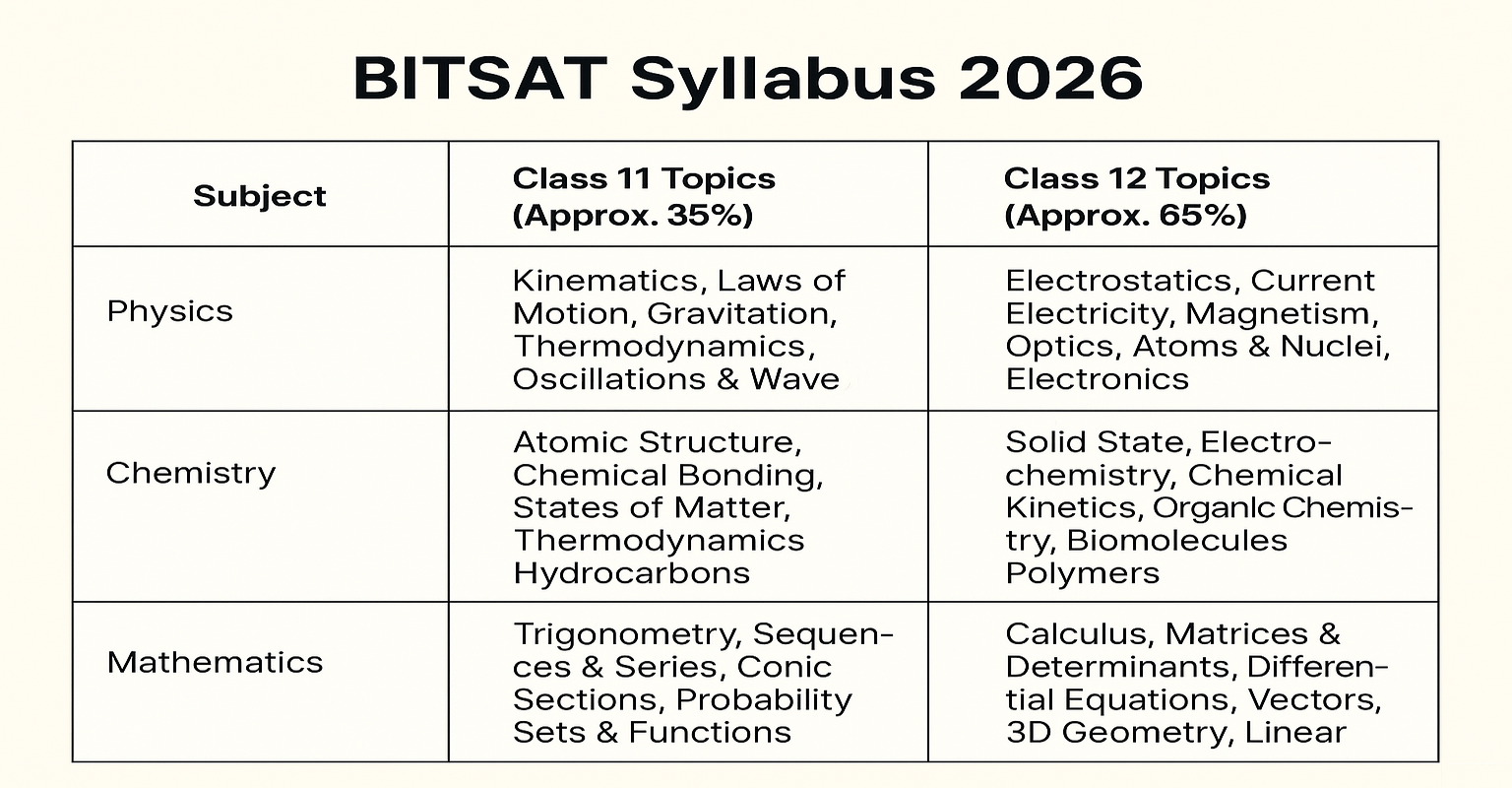
Related Links:
Ques. Is the BITSAT syllabus reduced?
Ans. As per the latest official update, there is no reduction in the BITSAT 2026 syllabus.
- The topics for BITSAT have been kept unchanged and still are from the NCERT books of Classes 11 and 12 for Physics, Chemistry, and Mathematics/Biology.
- Candidates must cover the entire NCERT syllabus thoroughly, as the questions are conceptual and often application-based.
Ques. Is NCERT enough for BITSAT?
Ans. NCERT textbooks play a significant role in establishing the base of your concepts. However, BITSAT demands not only deep conceptual understanding but also your speed and accuracy. So, in order to prepare thoroughly, students need to accompany the NCERT with some reference books and practice tests.
| Preparation Source | Remarks |
|---|---|
| NCERT Textbooks (Class 11 & 12) | Crucial for core theory, definitions, and basic numerical concepts. |
| Reference Books (e.g., H.C. Verma, R.D. Sharma, O.P. Tandon) | Important for advanced concepts, tricky numericals, and problem-solving. |
| Previous Year Papers & Mock Tests | Helps improve speed, accuracy, and familiarity with BITSAT’s online format. |
BITSAT Subject-wise Syllabus
BITSAT 2026 syllabus aims to check the conceptual understanding, abilities application and analytical reasoning. Generally, the BITSAT questions are based on the NCERT Class 11 and 12 topics, but those are frequently conceptually deeper and application-oriented.
In BITSAT, Physics and Mathematics require strong numerical and logical reasoning skills, while Chemistry tests a balance of concepts, reactions, and applications.
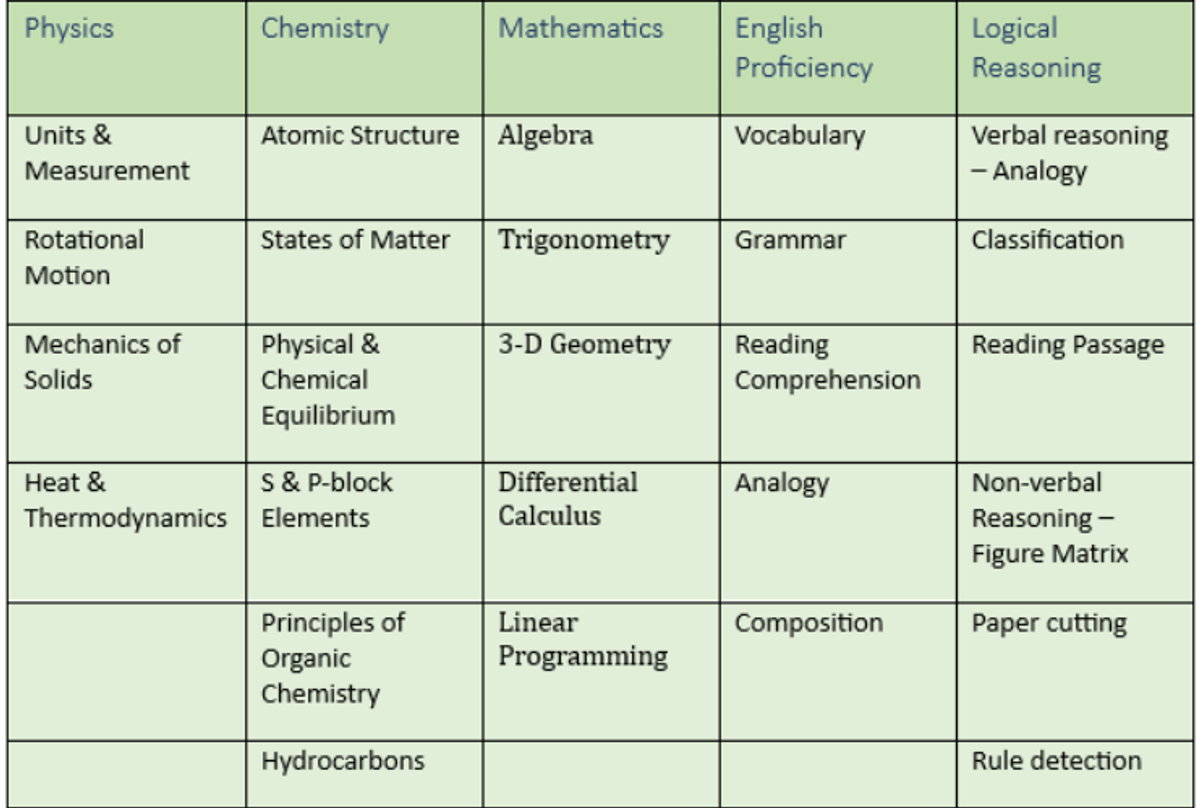
BITSAT Physics Syllabus
- Physics is a major factor in BITSAT and basically involves application-based and numerical-type questions.
- Almost 40% of the Physics section is covered by Mechanics, Current Electricity, and Modern Physics. Concept clarity, along with formula-based practic,e should be the focus of the candidates.
| Topic | Key Areas |
|---|---|
| Physical World & Units | Units, Dimensions, Errors, Measurement |
| Kinematics | Motion in 1D & 2D, Projectile Motion, Relative Velocity |
| Laws of Motion | Newton’s Laws, Friction, Circular Motion |
| Work, Energy & Power | Work-Energy Theorem, Potential Energy, Power |
| Rotational Motion | Moment of Inertia, Torque, Angular Momentum |
| Gravitation | Universal Law, Satellite Motion, Escape Velocity |
| Oscillations & Waves | Simple Harmonic Motion, Wave Motion, Sound Waves, Doppler Effect |
| Electrostatics | Coulomb’s Law, Electric Field, Potential, Capacitance |
| Current Electricity | Ohm’s Law, Circuits, Resistivity |
| Magnetism & EMI | Magnetic Field, Electromagnetic Induction, AC Circuits |
| Optics | Reflection, Refraction, Lenses, Interference, Diffraction |
| Modern Physics | Dual Nature, Atoms, Nuclei, Radiation |
| Electronics | Semiconductors, Diodes, Transistors |
BITSAT Chemistry Syllabus
- Chemistry is based on concepts, and the students are required to apply those concepts.
- The main focus of Physical Chemistry is on numerical problems, while Organic Chemistry concentrates on reaction mechanisms, and Inorganic Chemistry is mainly for checking the students’ factual understanding.
- Approximately 35 to 40% of the questions come from Physical Chemistry.
| Topic | Key Areas |
|---|---|
| Some Basic Concepts | Mole Concept, Atomic & Molecular Mass, Stoichiometry |
| States of Matter | Gas Laws, Kinetic Theory, Liquefaction of Gases |
| Atomic Structure | Quantum Numbers, Electronic Configuration |
| Chemical Bonding | VSEPR Theory, Hybridisation, Molecular Orbital Theory |
| Thermodynamics | Enthalpy, Internal Energy, Hess’s Law |
| Equilibrium | Chemical & Ionic Equilibrium, pH, Buffer Solutions |
| Redox Reactions | Oxidation Number, Balancing Reactions |
| Solid State | Crystal Lattices, Packing Efficiency, Defects |
| Solutions | Concentration Terms, Raoult’s Law, Colligative Properties |
| Electrochemistry | Electrochemical Cells, Nernst Equation |
| Chemical Kinetics | Rate Laws, Order, Molecularity |
| Surface Chemistry | Adsorption, Catalysis, Colloids |
| p-Block, d-Block & f-Block | Periodic Properties, Compounds, Reactions |
| Coordination Compounds | Ligands, Bonding, Isomerism |
| Organic Chemistry | Hydrocarbons, Alcohols, Aldehydes, Ketones, Acids |
| Biomolecules & Polymers | Proteins, Carbohydrates, Vitamins, Synthetic Polymers |
| Environmental Chemistry | Pollution, Green Chemistry, Ozone Layer |
BITSAT Mathematics Syllabus
- Mathematics is the most important part of BITSAT, and the main features of the subject are speed, accuracy, and logical thinking.
- The topics contribute to the overall question paper, Calculus, Coordinate Geometry, and Algebra have more than 50% of the total math section.
| Topic | Key Areas |
|---|---|
| Sets, Relations & Functions | Domain, Range, Types of Functions |
| Complex Numbers & Quadratic Equations | Argand Plane, Modulus, De Moivre’s Theorem |
| Permutations & Combinations | Factorial, Arrangements, Selections |
| Binomial Theorem | General Term, Middle Term |
| Sequences & Series | Arithmetic & Geometric Progressions, Sums |
| Straight Lines & Circles | Slope, Equation, Tangents & Normals |
| Conic Sections | Parabola, Ellipse, Hyperbola |
| Limits, Continuity & Differentiability | Derivatives, Chain Rule, Mean Value Theorem |
| Integral Calculus | Definite & Indefinite Integrals, Area Under Curve |
| Differential Equations | Formation, Order, Degree, Solutions |
| Vectors & 3D Geometry | Dot & Cross Product, Direction Cosines |
| Probability | Conditional Probability, Bayes’ Theorem |
| Matrices & Determinants | Inverse, Cramer’s Rule, Applications |
| Mathematical Reasoning | Statements, Logic, Truth Tables |
| Statistics | Mean, Variance, Standard Deviation |
BITSAT English Syllabus
- English contributes around 8% of the total marks.
- Focus on reading comprehension, grammar, and vocabulary.
| Topic | Key Areas |
|---|---|
| Reading Comprehension | Understanding passages, answering questions |
| Grammar | Sentence correction, tenses, prepositions, and conjunctions |
| Vocabulary | Synonyms, Antonyms, Word Usage |
| Sentence Completion | Completing sentences with correct words |
BITSAT Logical Reasoning Syllabus
- Logical Reasoning carries 15% of the total marks.
- Focus on pattern recognition, analytical thinking, and problem-solving.
| Topic | Key Areas |
|---|---|
| Analogy | Identifying relationships between pairs |
| Classification | Grouping items based on characteristics |
| Series | Number series, Letter series, Analogy series |
| Coding-Decoding | Deciphering codes and patterns |
| Blood Relations | Understanding family relationships |
| Direction Sense Test | Determining directions and distances |
| Venn Diagrams | Logical relationships between sets |
| Syllogisms | Deductive reasoning from premises |
Read more :
- BITSAT 2026 Physics Syllabus
- BITSAT Chemistry Syllabus
- BITSAT Mathematics Syllabus
- BITSAT English and LR Syllabus 2026
Ques. Can I write BITSAT without Mathematics?
Ans. No, it is not allowed. BITSAT is the entrance exam for B.E. (Engineering) programs and in that case, Mathematics is a must-have subject for the candidates.
- Those students who do not have Mathematics are not allowed to take B.E. (Engineering) BITSAT.
- On the other hand, the aspirants of B.Pharm have Biology in place of Mathematics as one of their subjects, and they are eligible to write the BITSAT exam.
Ques. How many subjects are there in BITSAT?
Ans. The BITSAT 2026 exam includes four sections -Physics, Chemistry, Mathematics (or Biology for B.Pharm), and English Proficiency & Logical Reasoning. Each section has a fixed number of questions and equal importance in the final score.
| Subject | Total Questions | Marks | Weightage |
|---|---|---|---|
| Physics | 30 | 90 | 23% |
| Chemistry | 30 | 90 | 23% |
| Mathematics / Biology | 40 | 120 | 31% |
| English Proficiency & Logical Reasoning | 30 | 90 | 23% |
| Total | 130 | 390 | 100% |
BITSAT 2026 Syllabus: Topic-Wise Weightage
- The BITSAT 2026 Syllabus will be based on the NCERT Class 11 & 12 curriculum. However, certain topics carry more weight in the exam.
- Based on previous year trends and student analysis, about 60–65% of the marks come from high-weightage chapters across all subjects.
- Focusing on these topics strategically will help candidates maximise their BITSAT scores.
BITSAT Physics Weightage
- The Physics section in BITSAT includes a mix of conceptual and numerical questions.
Mechanics, Electromagnetism, and Modern Physics together form nearly 45% of the total Physics questions.
- Optics and Thermodynamics often contain direct, formula-based problems.
| Physics Topic | Approx. Weightage |
|---|---|
| Mechanics (Laws of Motion, Work, Power, Energy, Rotational Motion, Gravitation, Oscillations) | 20–22% |
| Electrostatics & Current Electricity | 12–14% |
| Magnetism & Electromagnetic Induction | 10–12% |
| Optics (Ray & Wave Optics) | 8–10% |
| Thermodynamics & Kinetic Theory | 6–8% |
| Modern Physics (Atoms, Nuclei, Dual Nature, Semiconductor) | 8–10% |
| Waves & Properties of Matter | 5–7% |
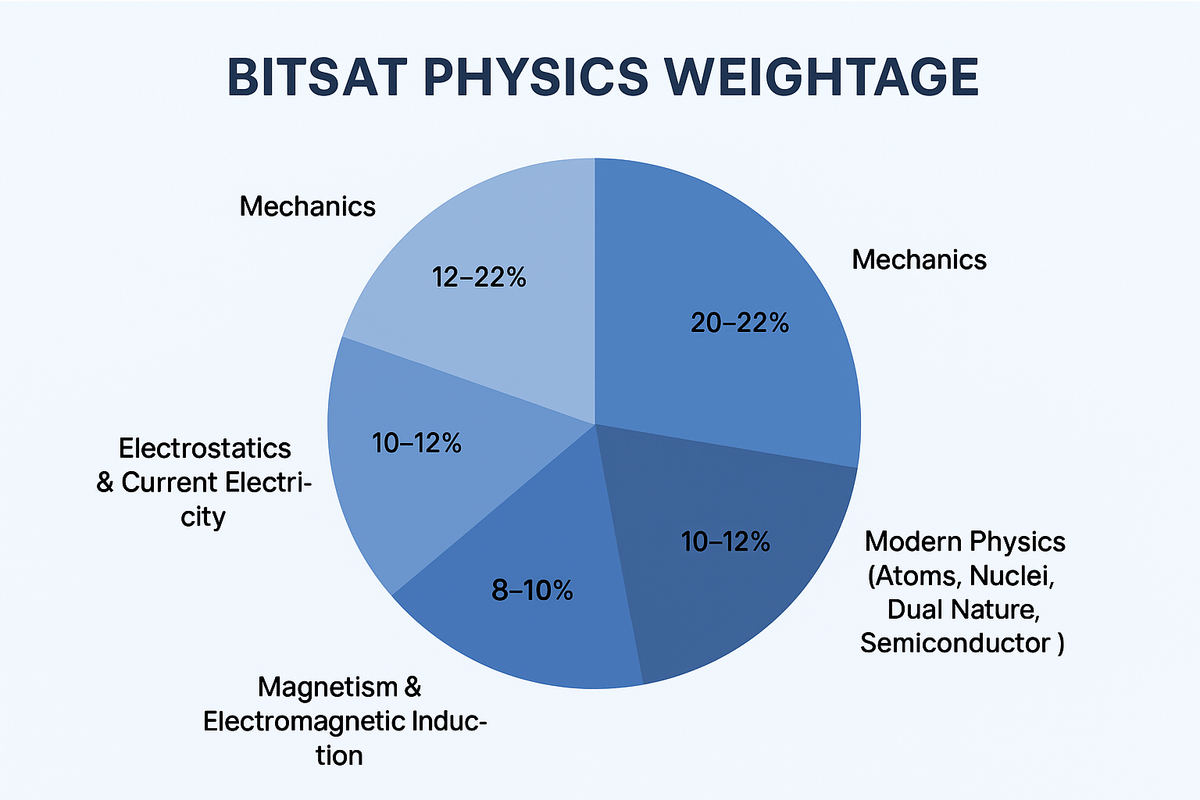
BITSAT Chemistry Weightage
- The Chemistry section has a balanced mix of Organic, Physical, and Inorganic Chemistry.
- Organic Chemistry holds the highest weightage, followed by Physical Chemistry with numerical problems.
- Inorganic Chemistry is the most scoring with factual and direct questions.
| Chemistry Topic | Approx. Weightage |
|---|---|
| Organic Chemistry (Hydrocarbons, Alcohols, Aldehydes, Carboxylic Acids, Amines, Biomolecules) | 30–35% |
| Physical Chemistry (Thermodynamics, Equilibrium, Electrochemistry, Chemical Kinetics, Solutions) | 18–20% |
| Inorganic Chemistry (Periodic Table, p-block, d-block, Coordination Compounds, Hydrogen, S-Block) | 15–18% |
| Atomic Structure & Chemical Bonding | 8–10% |
| Surface Chemistry & Environmental Chemistry | 5–7% |
| Miscellaneous (Polymers, Chemistry in Everyday Life) | 4–6% |
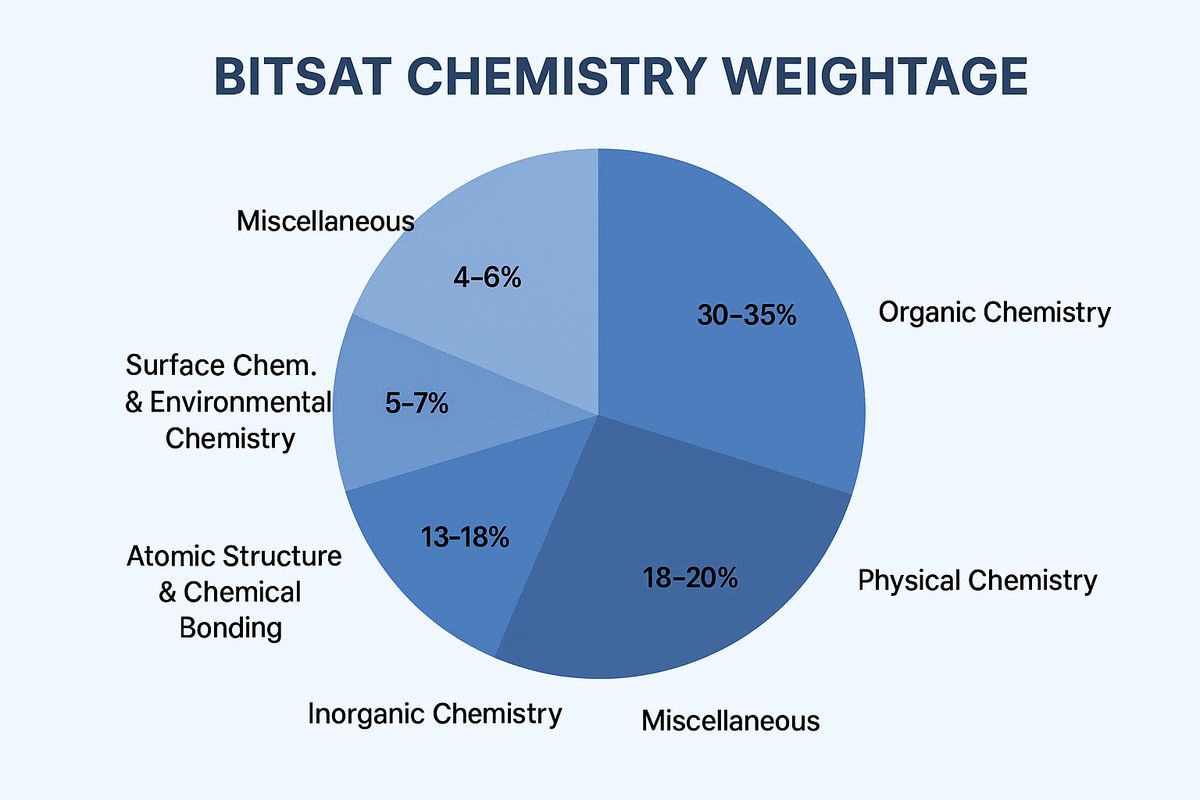
BITSAT Mathematics Weightage
- Mathematics is the most crucial section in BITSAT, as it carries a large portion of the total marks and determines percentile ranking significantly.
- Chapters like Calculus, Algebra, and Coordinate Geometry dominate the paper, followed by Vectors and Probability.
| Mathematics Topic | Approx. Weightage |
|---|---|
| Calculus (Limits, Differentiation, Integration, Applications) | 25–28% |
| Algebra (Complex Numbers, Binomial Theorem, Sequences & Series, Matrices & Determinants) | 14–16% |
| Coordinate Geometry (Straight Lines, Circles, Parabola, Ellipse, Hyperbola) | 12–14% |
| Vectors & 3D Geometry | 10–12% |
| Probability & Statistics | 6–8% |
| Trigonometry | 6–8% |
| Sets, Relations & Functions | 4–6% |
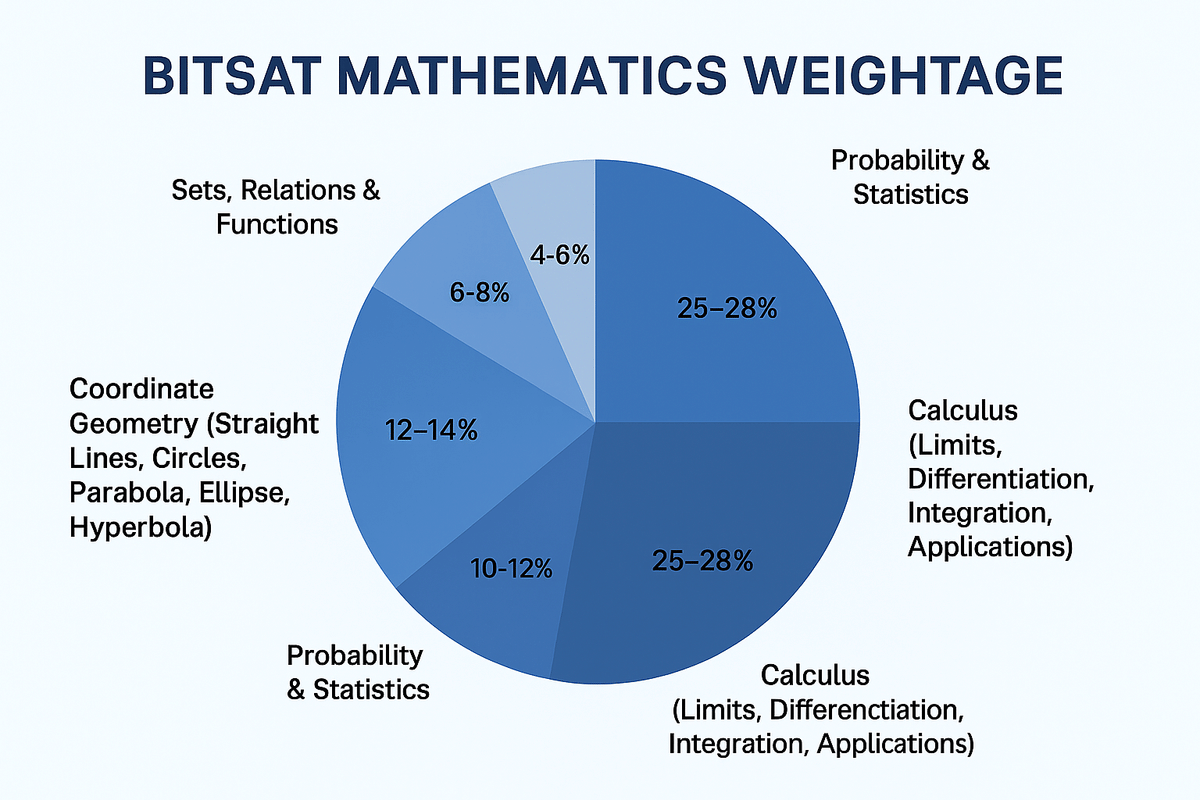
BITSAT English Proficiency & Logical Reasoning Weightage
This section tests candidates’ language comprehension and analytical skills. Logical Reasoning has slightly higher difficulty, while English questions are straightforward.
| Section | Approx. Weightage |
|---|---|
| English Proficiency (Synonyms, Antonyms, Grammar, Sentence Completion, Reading Comprehension) | 50% |
| Logical Reasoning (Series, Coding-Decoding, Analogy, Puzzle, Visual Reasoning) | 50% |

Also Check: Download BITSAT 2025 Question Paper
Ques. Does BITSAT include the Class 11 syllabus?
Ans. Yes, BITSAT covers both Class 11 and Class 12 topics based on NCERT guidelines.
In BITSAT, roughly 30–35% of questions come from the Class 11 syllabus, while 65–70% are from the Class 12.
Class 11 topics form the foundation for advanced Class 12 concepts.
Ques. What is the weightage of Class 11 and Class 12 in BITSAT?
Ans. BITSAT gives more emphasis to Class 12 topics to test in-depth understanding.
| Academic Class | Approximate Weightage | Question Distribution (out of 150) |
|---|---|---|
| Class 11 | 30–35% | 45–50 Questions |
| Class 12 | 65–70% | 100–105 Questions |
Based on previous year trends, around 65–70% of questions are from Class 12 topics and 30–35% from Class 11.
BITSAT tests conceptual clarity, analytical skills, and speed, so focusing on high-weightage topics can help maximise scores.
| Subject | Most Important Topics | Weightage Trend |
|---|---|---|
| Physics | Mechanics, Electrostatics, Current Electricity, Magnetic Effects, Modern Physics | High (25–28 Questions) |
| Chemistry | Physical Chemistry: Thermodynamics, Chemical Kinetics; Organic Chemistry: Reaction Mechanisms, Basic Principles; Inorganic Chemistry: Coordination Compounds, Chemical Bonding | Moderate-High (18–22 Questions) |
| Mathematics | Algebra, Calculus, Coordinate Geometry, Trigonometry, Probability, Vectors & 3D Geometry | High (30–32 Questions) |
| English & Logical Reasoning | Reading Comprehension, Vocabulary, Sentence Completion, Analytical & Logical Reasoning | Moderate (15–20 Questions) |
Download BITSAT Practice Papers
Ques. What will be my rank if I score 150 in BITSAT?
Ans. Candidates scoring around 150 in BITSAT usually fall in the mid-tier range, as the exam is relatively scoring-friendly but competitive.
| Score Range | Expected Rank Range | Remarks |
|---|---|---|
| 140–160 | 10,000 – 20,000 | Eligible for BITS campuses like Pilani (lower preference branches) |
| 160–180 | 5,000 – 10,000 | Moderate chance for top BITS campuses (less preferred branches) |
Ques. What is a safe score for BITSAT 2026?
Ans. The safe score in BITSAT depends on competition and the number of seats, but follows a similar pattern each year.
| College Type | Safe Score Range | Expected Rank Range |
|---|---|---|
| Top BITS Campuses (Pilani, Goa, Hyderabad) | 260–320 | 1–3,000 |
| Mid-Tier BITS Branches | 220–260 | 3,000–8,000 |
| Lower Tier BITS Branches | 180–220 | 8,000+ |
BITSAT 2026 Exam Pattern
- BITSAT 2026 (Birla Institute of Technology and Science Admission Test) is a computer-based test (CBT).
- The exam will consist of 130 multiple-choice questions (MCQs) and 10 extra bonus questions, making the total duration 3 hours (180 minutes).
- Along with every correctly answered question, +3 marks are given, but for every wrongly answered question 1 mark is deducted.
- Each section is not timed, meaning that you are allowed to move between sections at your convenience.

Read more: BITSAT Exam Pattern 2026
BITSAT Syllabus 2026 FAQs
Ques. Who is eligible for BITSAT 2026?
Ans. The BITSAT Eligibility 2026 includes educational qualifications, subject requirements, and nationality. It is for candidates seeking admission to B.E./B.Pharm courses at BITS campuses (Pilani, Goa, and Hyderabad).
| Criteria | Details |
|---|---|
| Nationality | Indian citizens, OCI, and NRI candidates are eligible. |
| Educational Qualification | Must have passed Class 12 or equivalent with Physics, Chemistry, and Mathematics (for B.E.) / Biology (for B.Pharm) as compulsory subjects. |
| Minimum Marks | At least 75% aggregate in PCM/PCB and at least 60% in each subject. |
| Additional Subjects | English must be studied as one of the subjects. |
| For B.Pharm | PCM in Class 12 is required along with Biology as an optional subject. |
Ques. How to prepare for BITSAT 2026?
Ans. For BITSAT preparation, candidates should follow a conceptual understanding approach along with regular practice and mock test analysis.
| Step | Preparation Focus |
|---|---|
| 1 | Understand Syllabus & Pattern – Revise Class 11–12 NCERT thoroughly, analyse chapter-wise weightage. |
| 2 | Make Formula & Concept Notes – Especially for Physics & Chemistry numerical and Biology diagrams. |
| 3 | Attempt Previous Year Questions & Mock Tests – Solve at least 10–15 papers to understand difficulty trends. |
| 4 | Focus on Strong Areas – Strengthen high-weightage chapters like Calculus, Mechanics, Electrostatics, and Genetics. |
| 5 | Time Management – Practice completing 150 questions in 3 hours efficiently. |
Ques. Is 300 marks good in BITSAT?
Ans. A score of 300 marks or more in BITSAT 2026 is considered strong and usually places candidates in the top percentile.
| Score Range | Expected Rank Range | Admission Possibility |
|---|---|---|
| 350–450 | 1 – 500 | Top Programs in Pilani, Goa, Hyderabad |
| 300–350 | 500 – 2,000 | Good B.E./B.Pharm branches |
| Below 250 | 5,000+ | Moderate scoring branches |
Ques. What can I get with 280 marks in BITSAT?
Ans. A score of 280 marks indicates strong performance and allows admission into mid to upper-tier branches and campuses.
| Score | Predicted Rank Range (2026) | Possible Branches/Colleges |
|---|---|---|
| 270–290 | 2,000 – 3,500 | Computer Science (Goa), EEE, Civil (Pilani) |
| 290–310 | 1,500 – 2,000 | Mechanical, Electrical, B.Pharm (Hyderabad) |
| 250–270 | 3,500 – 5,000 | Electronics, Chemical, B.Pharm (Pilani) |
Ques. Which colleges accept BITSAT 2026 scores?
Ans. BITS campuses in Pilani, Goa, and Hyderabad accept BITSAT scores for admission into B.E. and B.Pharm courses.
| College Name | Location | Expected Cutoff (Marks) |
|---|---|---|
| BITS Pilani | Pilani | 320–400 |
| BITS Goa | Goa | 300–370 |
| BITS Hyderabad | Hyderabad | 310–380 |
Ques. What is the rank for 200 marks in BITSAT?
Ans. A score of 200 marks is moderate and generally places candidates in the mid-to-lower percentile.
| Score | Expected Rank Range (2026) | Admission Possibility |
|---|---|---|
| 200 | 10,000 – 12,000 | Eligible for lower-tier branches or campuses |
*The article might have information for the previous academic years, which will be updated soon subject to the notification issued by the University/College.



Comments
Found 1 Comment
i want to know the syllabus of BITSAT
BITSAT is conducted for admission in BE/B.Tech, B.Pharma and M.Sc programs. The examination syllabus is program-specific. Please check the examination syllabus for the respective programs BITSAT Syllabus.